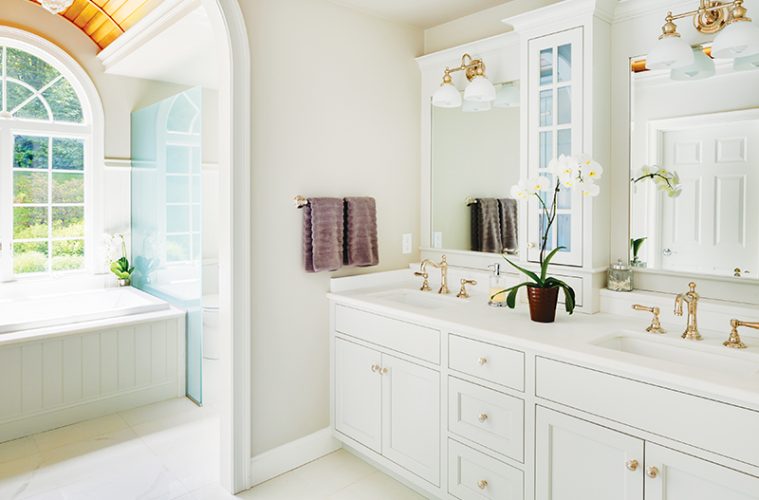While many traditional styles are still embraced by New England homeowners, the bathroom is one room where renovations often bring innovative fixtures and designs. At Designer Bath and Salem Plumbing Supply, owner Jason Sevinor has seen a trend toward transitional styles. “New England used to be all about traditional design, but that’s not the whole story anymore,” he says. “Transitional styles are all about clean lines—they fall somewhere between traditional and modern.” Designer Bath and Salem Plumbing Supply’s showroom in Beverly offers customers the opportunity to browse varied styles, whether traditional, transitional, or modern.
“Many customers are gravitating toward wall-hung vanities, which are very popular in Europe,” Sevinor explains. Lit mirrors and recessed lighting are also gaining popularity over traditional sconces—hidden lighting allows for brighter, more welcoming light without large, intrusive fixtures.
Shower technology has also developed in recent years. “Many clients are increasing the size of their showers,” says Sevinor. New technology allows customers to reinvent their showers, turning them into steam spas. “The shower’s steam head can offer different types of therapies,” explains Sevinor.
“We see a lot of people using aromatherapy—canisters of different scents can be piped in through the steam system.” Chromotherapy for relaxation has also become popular—different colored lights elicit different emotional responses. It’s also common for people to add Bluetooth-compatible radios or speakers to their showers. “With the addition of color, scent, and sound therapies, the shower can become a very efficient place to relax,” says Sevinor.
Susan and Steve Howell of Howell Custom Building Group have also noticed a trend toward the transitional. “The most common reason for clients choosing to remodel is that their current bath no longer meets their needs—whether it’s outdated, too small, or plagued by moisture issues,” explains Susan. While the Howells often see bathrooms whose renovations are necessitated by the need to address problems, many clients will take it as an opportunity to update their baths with newer or more fitting fixtures. “We’re seeing many clients moving away from the large tub or Jacuzzi trend that was very popular in the ’80s and ’90s,” Steve adds.
“Homeowners are creating more space in their baths by removing these large fixtures and replacing them with smaller, freestanding soaking tubs, or sometimes removing the tub altogether in favor of a larger, more modern shower.”
Maximizing the space in a bathroom is key to a satisfactory remodel. “While the majority of homeowners choose to work within the space they have,” notes Steve, “some of our clients expand the room by adding dormers or [moving] into an adjacent closet.” Skylights and larger windows are also in favor, as they provide more natural light. Other innovations include anti-fog mirrors, medicine cabinets with built-in electrical outlets for charging razors or toothbrushes, and heated floors. “We also see clients becoming more creative with their design choices,” says Susan. “Homeowners face new space challenges that require us to think differently—for example, instead of adding another bath, homes with two working adults will renovate an older bath by adding a double vanity, to streamline their mornings.” She also notes a trend toward stylish tile design using natural and recycled materials.
Susan suggests that before beginning renovations, people should look for inspiration online and put together a folder of ideas. “It’s very important that clients balance their budget with their wish list,” Steve adds. “That’s where designers and builders can help clients prioritize what they need, what they want, and what can be omitted or replaced.”

